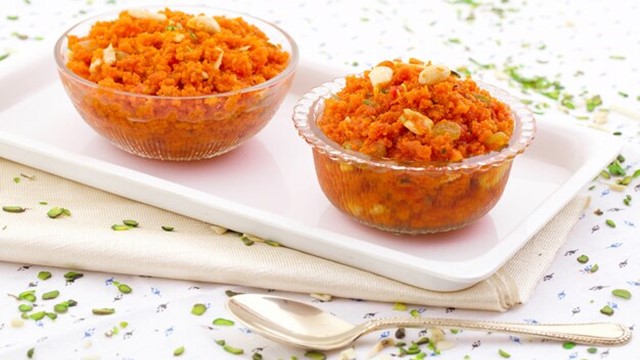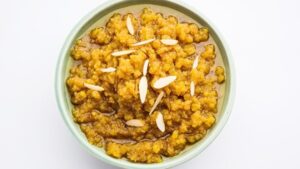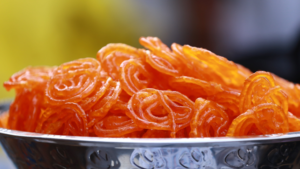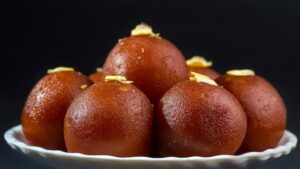Gajar ka Halwa, also known as Carrot Halwa or Gajrela, is a traditional and immensely popular Indian dessert that originates from the North Indian state of Punjab. This sweet delicacy is made primarily from grated carrots, milk, sugar, ghee (clarified butter), and a variety of nuts and spices.
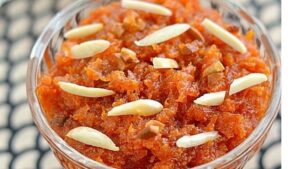
Culinary Significance:
The culinary significance of Gajar ka Halwa goes beyond its delicious taste; it holds cultural and traditional importance within Indian cuisine for various reasons:
Festive Celebrations:
- Symbol of Festivity: Gajar ka Halwa is a quintessential part of celebratory occasions and festivals in India. It is prominently featured during joyous events like Diwali, weddings, birthdays, and other auspicious gatherings.
- Auspicious Offering: Often offered as Prasad (sacred offering) in temples or religious ceremonies, symbolizing sweetness and divine blessings.
Seasonal Connection:
Winter Delicacy:
It is especially popular during the winter season when fresh, sweet carrots are abundantly available. Its preparation coincides with the season’s harvest, making it a comforting and celebratory winter dessert.
Culinary Heritage:
Traditional Recipe:
Gajar ka Halwa’s recipe has been passed down through generations, preserving culinary traditions and family legacies. It’s often prepared with love and care, following age-old family recipes.
Symbol of Sweetness and Prosperity:
- Signifying Joy: The sweetness of Gajar ka Halwa represents joy, happiness, and togetherness, making it an integral part of shared moments and celebrations.
Versatile Appeal:
All-age Favorite: Its popularity spans across generations. Loved by children and adults alike, it evokes nostalgic memories and satisfies sweet cravings.
Emotional Connections:
- Nostalgia and Comfort: For many, Gajar ka Halwa holds sentimental value, evoking nostalgic feelings of home-cooked comfort, family gatherings, and cherished moments.
Culinary Craftsmanship:
- Art of Slow Cooking: The slow and patient cooking process involved in making Gajar ka Halwa, where grated carrots are simmered with milk, sugar, and spices, showcases culinary craftsmanship and attention to detail.
Fusion and Adaptations:
- Modern Twists: While maintaining its traditional essence, chefs and enthusiasts experiment with innovative variations, incorporating healthier ingredients or presenting it in contemporary forms to suit evolving tastes.
Cultural Legacy:
- Cultural Pride: Its prominence within Indian cuisine symbolizes cultural richness and diversity, reinforcing the significance of regional flavors and culinary traditions.
Gajar ka Halwa is not just a dessert; it’s a cultural icon that encapsulates the essence of celebration, togetherness, and the rich culinary heritage of India, making it an inseparable part of festive occasions and cherished family traditions.
Variations:
Gajar ka Halwa, despite being a classic dessert, comes in various regional and modern adaptations, showcasing its versatility and catering to diverse tastes. Here are some notable variations:
Regional Varieties:
Traditional Recipe Variations:
North Indian Style:
The classic recipe involves slow-cooking grated carrots with milk, sugar, ghee, and spices like cardamom until the carrots soften and absorb the flavors.
Punjabi Style:
Some Punjabi variations may include adding khoya (milk solids) for a richer texture or using jaggery instead of sugar for a unique taste.
South Indian Influence:
Kerala Special:
In Kerala, Gajar ka Halwa might incorporate coconut milk or grated coconut, offering a tropical twist to the traditional recipe.
Modern Adaptations:
- Healthier Versions:
- Low-Sugar Variants: Health-conscious versions may reduce sugar content or use natural sweeteners like dates, figs, or stevia.
- Vegan or Dairy-Free Options: Using coconut milk or almond milk instead of dairy milk for those following a vegan lifestyle.
- Innovative Additions:
- Nutty Varieties: Adding a variety of nuts like cashews, almonds, or walnuts to enhance the crunch and nutritional profile.
- Fruit Infusions: Incorporating fruits like pineapple, mango, or apple to add a fruity dimension to the dessert.
- Chef Specials and Fusion Delights:
- Restaurant Specials: Upscale restaurants may experiment with presentation, incorporating artistic elements or serving it with gourmet twists.
- Fusion Treats: Gajar ka Halwa might be transformed into innovative desserts like ice cream, cakes, tarts, or trifle puddings, blending traditional flavors with modern trends.
- Instant or Quick Versions:
- Microwave Recipes: Quick microwave recipes are available, reducing the traditional cooking time significantly for a faster preparation process.
Personal and Family Recipes:
- Family Secret Recipes:
- Unique Family Traditions: Every family may have its secret techniques or variations passed down through generations, making each recipe unique and special.
- Customized Creations:
- Creative Experimentation: Enthusiasts often experiment by adding their favorite ingredients or adjusting spice levels to create personalized versions.
Gajar ka Halwa’s versatility allows it to adapt to diverse tastes, dietary preferences, and regional influences, making it a dessert cherished not only for its classic appeal but also for its ability to evolve with changing times and palates.
Storage and Shelf Life:
Gajar ka Halwa, like many desserts, has specific storage recommendations to maintain its quality and taste over time:
Storage Guidelines:
Refrigeration:
- Short-term Storage: Store leftover Gajar ka Halwa in an airtight container in the refrigerator within 2 hours of preparation.
- Duration: It can typically be refrigerated for up to 3-4 days without compromising its taste or quality.
Freezing:
- Longer-term Storage: If planning to store it for a more extended period, Gajar ka Halwa can be frozen.
- Packaging: Place it in an airtight container or resealable freezer bags, ensuring minimal air exposure to prevent freezer burn.
- Duration: It can remain frozen for around 1-2 months without significant alterations in taste.
Reheating and Serving:
Reheating Tips:
- Thawing: If frozen, thaw the Gajar ka Halwa in the refrigerator overnight before reheating.
- Reheating Method: Reheat in a microwave or on the stovetop, adding a splash of milk or cream to restore moisture and freshness.
- Garnishing: Consider adding a sprinkle of nuts or a dash of cardamom for a fresh touch before serving.
Shelf Life Considerations:
Quality Changes:
- Flavor Intensification: Over time, the flavors of Gajar ka Halwa tend to intensify, potentially enhancing its taste after being stored for a day or two.
- Texture Changes: The texture might become denser upon refrigeration or freezing, but it generally retains its deliciousness.
Cautionary Notes:
- Food Safety: Ensure the dessert is stored in clean, airtight containers to prevent contamination or spoilage.
- Odor Absorption: Store it away from strongly scented foods to prevent absorption of other odors.
By following these storage guidelines, you can prolong the shelf life of Gajar ka Halwa, preserving its flavors and ensuring a delightful treat even after storing it for a few days.
Emotional Connections:
Sentimental Value:
- Nostalgia and Memories: For many, the aroma and taste of Gajar ka Halwa evoke fond memories of childhood, home-cooked meals, and festive celebrations.
Family Traditions:
- Generational Recipes: Passing down recipes from one generation to another strengthens familial bonds and keeps culinary traditions alive.
Gajar ka Halwa, beyond being a sweet dessert, embodies cultural traditions, seasonal connections, and emotional ties, making it more than just a culinary delight—it’s a representation of cultural heritage and shared moments of joy and celebration.
Recipe
Here’s a classic recipe for Gajar ka Halwa (Carrot Halwa):
Ingredients:
- 1 kg (2.2 lbs) carrots, peeled and grated
- 1 liter (4 cups) full-fat milk
- 1 cup sugar (adjust to taste)
- 1/2 cup ghee (clarified butter)
- 1/2 cup mixed nuts (almonds, cashews, pistachios), chopped
- 1/2 teaspoon cardamom powder
- A pinch of saffron strands (optional)
- Chopped nuts and edible silver leaf (varak) for garnish (optional)
Instructions:
- Preparation:
- Peel and grate the carrots using a grater or food processor. Set aside.
- Chop the mixed nuts and keep them ready.
- Cooking the Carrots:
- In a heavy-bottomed pan or a deep skillet, heat the ghee over medium heat.
- Add the grated carrots and sauté them in the ghee for about 5-7 minutes until they soften slightly.
- Simmering with Milk:
- Pour the milk into the pan with the carrots and mix well.
- Let the mixture simmer on medium-low heat, stirring occasionally to prevent sticking, until the carrots absorb most of the milk and the mixture thickens. This may take around 30-40 minutes.
- Adding Sweetener and Flavorings:
- Once the carrots have cooked and the milk has reduced significantly, add sugar to the mixture. Adjust the quantity based on desired sweetness.
- Stir continuously as the sugar dissolves, allowing the halwa to further thicken.
- Enhancing Flavors:
- Add the cardamom powder, saffron strands (if using), and chopped nuts to the halwa. Mix well, allowing the flavors to blend. Cook for an additional 5-7 minutes.
- Finishing Touches:
- Once the halwa reaches a thick, pudding-like consistency and the ghee starts to separate from the mixture, turn off the heat.
- Garnish with additional chopped nuts and edible silver leaf (if desired).
- Serving:
- Serve Gajar ka Halwa warm or at room temperature. It can be enjoyed on its own or paired with a scoop of vanilla ice cream for an indulgent treat.
Enjoy the Richness of Gajar ka Halwa!
This traditional recipe yields a delectably sweet and aromatic dessert that showcases the flavors of slow-cooked carrots, milk, nuts, and fragrant spices, offering a delightful culinary experience perfect for celebrations or as a comforting treat on any occasion. Adjust the sweetness and richness according to your preference for an irresistible homemade dessert!

